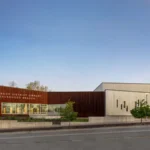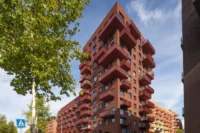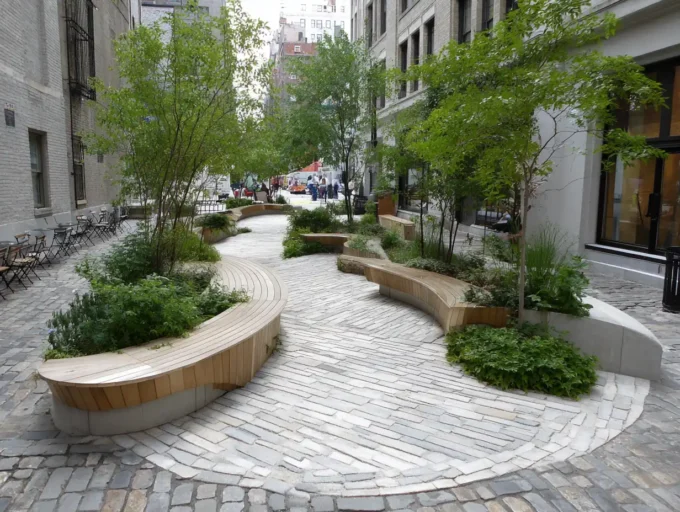Urban space design in architecture shapes the way we experience our cities. As we navigate bustling streets and serene parks, the design of these spaces influences our interactions and well-being. Thoughtful urban design creates environments that foster community, enhance sustainability, and reflect cultural identity.
We’re living in an age where the demand for innovative urban spaces is greater than ever. With rapid urbanization and changing lifestyles, architects and planners are tasked with reimagining how we use and enjoy public spaces. From vibrant plazas to multifunctional parks, effective urban space design can transform our cities into thriving ecosystems that prioritize both functionality and beauty.

Overview of Urban Space Design in Architecture
Urban space design is vital for shaping engaging, functional environments that enhance the quality of life in cities. By focusing on thoughtful planning, we create public spaces that promote interaction, sustainability, and cultural identity.

Importance of Urban Space Design
Urban space design influences social interactions, economic activity, and environmental sustainability. Well-designed urban areas encourage community cohesion and inclusivity. They provide residents with accessible recreational spaces, which boosts public health. Additionally, sustainable designs help mitigate environmental impact, fostering a balance between urban development and nature. According to the American Planning Association, thoughtful urban design can enhance property values by up to 30%.
Key Principles of Urban Space Design
- Human-Centric Design: We focus on creating spaces that prioritize user experience, making them accessible and inviting for all community members.
- Sustainability: Design incorporates eco-friendly materials and practices, ensuring long-term environmental responsibility.
- Multifunctionality: We integrate diverse uses into spaces, allowing them to serve multiple purposes, thus enhancing their value and usage.
- Connectivity: Urban spaces connect various city elements, including transportation, neighborhoods, and green areas, facilitating movement and access.
- Cultural Reflection: Design elements incorporate local history and culture, strengthening community identity and pride.
These principles guide architects and planners in creating urban spaces that foster vibrant city life while addressing contemporary challenges.
Historical Context
Urban space design has evolved significantly over centuries, reflecting changing societal values and technological advancements. Understanding this historical trajectory provides context for contemporary architectural practices.

Evolution of Urban Space Design
Urban space design traces its roots to ancient civilizations, where functionality and communal life dictated layout. Ancient Greece and Rome emphasized public squares, known as agoras and forums, fostering social interaction and civic engagement. Middle Ages saw the rise of fortified towns, which prioritized security while still incorporating marketplaces and plazas.
The Renaissance period shifted focus towards aesthetics and symmetry, giving rise to grand boulevards and iconic landmarks. The industrial revolution introduced mass urbanization, leading to the creation of parks and recreational spaces as necessary respites. In the 20th century, modernism revolutionized urban space with concepts of efficiency and minimalism, transforming urban landscapes drastically.
Recent decades emphasize sustainability and inclusivity in urban design. Contemporary trends highlight multifunctional spaces that serve diverse community needs, integrating green spaces and technologies to promote environmental health and social interaction.
Influential Architectural Movements
Several architectural movements have profoundly impacted urban space design.
- Classical Architecture: Established enduring principles of beauty and order through symmetry and proportion, influencing city layouts.
- Modernism: Introduced a focus on functionality, with open spaces and materials like glass and steel that transformed urban environments.
- Postmodernism: Critiqued modernism’s rigidness, advocating for diversity in styles and cultural references within urban design.
- Sustainable Architecture: Emphasizes ecological sensitivity, aiming for designs that minimize environmental impact and enhance community resilience.
- New Urbanism: Promotes walkable neighborhoods, mixed-use development, and public transport to create cohesive, vibrant communities.
These movements illustrate how urban space design continually adapts to societal needs, ecological considerations, and cultural contexts.
Current Trends in Urban Space Design
Urban space design increasingly prioritizes sustainable practices and technological innovation. These trends shape vibrant, functional environments that enhance our urban experiences and community well-being.

Sustainable Practices
Sustainable practices in urban space design focus on reducing environmental impact while promoting resilience. Integrating green roofs and urban gardens supports biodiversity and mitigates heat islands. Utilizing permeable materials prevents stormwater runoff and enhances groundwater recharge. Incorporating renewable energy sources, like solar panels, powers public spaces and reduces carbon footprints. Promoting mixed-use developments encourages walkability, decreasing reliance on automobiles. Cities embracing sustainability often engage local communities in decision-making, ensuring that designs reflect diverse needs and identities.
Technology and Innovation
Technology and innovation increasingly influence urban space design, enhancing functionality and engagement. Smart city initiatives incorporate sensors and data analytics to optimize resource use and improve public safety. Interactive public installations leverage augmented reality, creating immersive experiences that educate and entertain visitors. Mobile apps guide residents to outdoor spaces, fostering community interaction. Advanced construction techniques, like 3D printing, reduce waste and accelerate project timelines. Urban spaces also integrate technology for improved accessibility, ensuring inclusivity for all individuals, regardless of abilities.
Impact of Urban Space Design
Urban space design profoundly influences communities and economies. Effective designs create environments that enhance engagement and drive economic growth.

Effects on Community Engagement
Thoughtful urban space design encourages community engagement. Designing inclusive public spaces fosters social interaction among diverse groups. For instance, well-planned plazas and parks promote gatherings and community events, facilitating connections among residents. Spaces that incorporate seating, greenery, and art attract people, transforming them into vibrant extensions of the neighborhood. Furthermore, these spaces often host local markets or cultural events, strengthening community ties. When communities participate in the design process, their unique needs and values influence outcomes, resulting in a sense of ownership and pride.
Economic Benefits
Urban space design contributes significantly to economic growth. Well-designed public spaces attract businesses and tourists, increasing foot traffic and generating revenue. Data show that vibrant neighborhoods with quality spaces often see higher property values, resulting in increased local tax revenues. By integrating mixed-use developments, urban design creates environments that support diverse economic activities, such as retail, dining, and services. Sustainable design practices can also reduce city maintenance costs by using durable materials and innovative drainage solutions, positively impacting local budgets. Moreover, inviting urban spaces enhance residents’ quality of life, making an area more desirable for potential homeowners and investors, ultimately driving long-term economic stability.
Challenges in Urban Space Design
Urban space design presents various challenges that impact our ability to create functional and aesthetically pleasing environments. Navigating regulations and balancing aesthetics with functionality remain significant hurdles for architects and planners.

Navigating Regulations
Navigating regulations entails understanding zoning laws, building codes, and environmental regulations that influence urban space design. Local governments often impose stringent guidelines to maintain safety, accessibility, and environmental standards. Complying with these regulations requires thorough research and collaboration with city planners and stakeholders. For example, in cities like San Francisco, specific regulations dictate the height or usage of new developments to preserve community character and prevent congestion. Architects must also consider historical preservation laws that protect significant sites, often complicating the design process. Thus, successfully maneuvering through these complexities ensures that designs align with both community vision and legal requirements.
Balancing Aesthetics and Functionality
Balancing aesthetics and functionality represents a fundamental challenge in urban space design. Designers aim to create visually appealing areas that resonate with cultural identity while also serving practical purposes. Spaces must accommodate various activities, such as recreation, events, and daily commuting, which complicates the design process. For instance, an appealing plaza might include art installations and seating options, yet must also consider traffic flow and safety measures for pedestrians. Additionally, striking the right balance often involves innovative approaches, like incorporating natural elements that enhance aesthetic value while improving environmental performance, such as green roofs and rain gardens. Addressing this challenge fosters vibrant urban spaces that enhance community engagement and well-being.
Conclusion
Urban space design plays a critical role in shaping our experiences in cities. It directly impacts community interaction, sustainability, and cultural identity. With rising urbanization and evolving lifestyles, the demand for innovative public spaces continues to grow. Architects and planners must reimagine urban environments to create thriving ecosystems that balance functionality with aesthetics.
Key principles such as human-centric design, sustainability, multifunctionality, connectivity, and cultural reflection guide us in crafting spaces that serve diverse purposes. These principles enhance public health, strengthen community identity, and address contemporary urban challenges effectively.
Historical perspectives illustrate how urban space design has evolved. From Ancient Greece and Rome’s public squares to the Renaissance’s focus on aesthetics, and the industrial revolution’s emphasis on parks, we see a clear trajectory of adaptation. Recent trends prioritize sustainability and inclusivity, showcasing a commitment to multifunctional spaces that integrate green areas and technology for holistic community benefits.
Influential architectural movements like Classical Architecture, Modernism, and Sustainable Architecture continue to shape urban space design, reflecting societal needs and ecological considerations. In today’s landscape, we see a stronger emphasis on sustainable practices, such as green roofs and advanced technologies, further enhancing urban space functionality and accessibility.
Effective urban designs not only enhance community engagement but also drive economic growth. By encouraging social interactions and hosting local markets, urban spaces solidify community ties and instill a sense of ownership among residents. These vibrant localities attract businesses and tourists, ultimately increasing property values and local tax revenues.
While challenges exist, such as navigating regulations and balancing aesthetics with functionality, innovative approaches can address these hurdles. Understanding zoning laws and building codes is essential to creating visually appealing and practical spaces that enhance safety and accessibility.
By focusing on these elements, urban space design can foster vibrant environments that significantly improve community engagement and well-being.
- Architectural Space Design
- city architecture trends
- city design strategies
- city planning
- city revitalization projects
- creative urban spaces
- downtown redevelopment
- modern urban architecture
- public space architecture
- sustainable urban design
- transforming cities
- urban architecture
- urban design consulting
- Urban design services
- urban infrastructure planning
- urban landscape design
- urban planning firms
- Urban Space Design
- urban space innovation
- urban space transformation
















Leave a comment